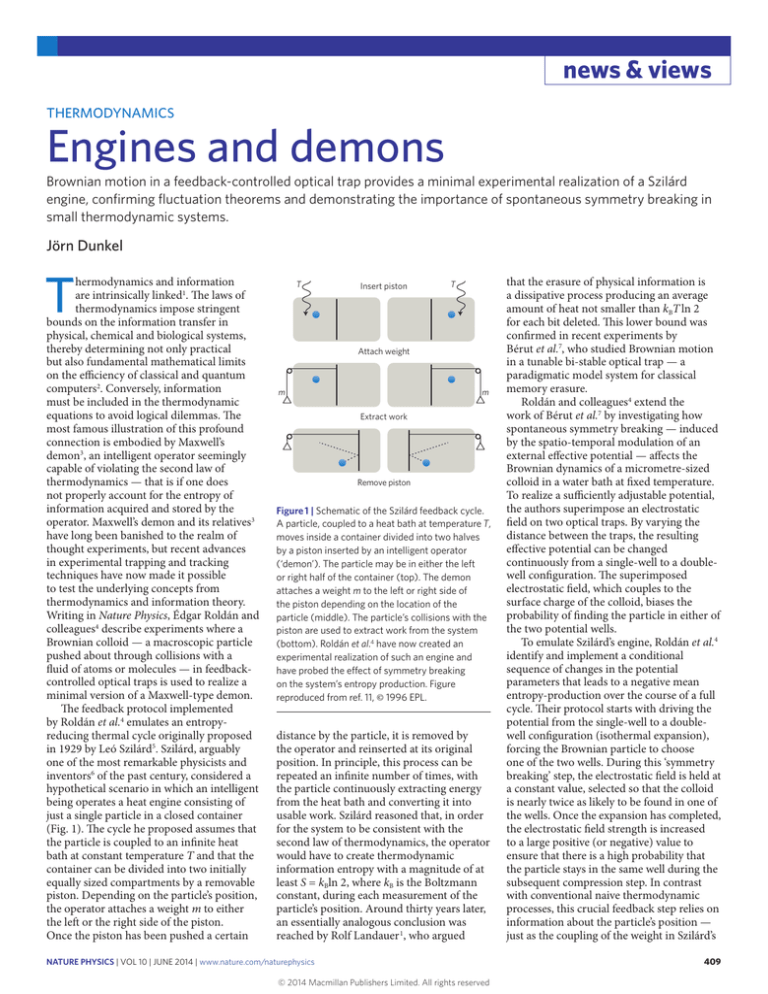
news & views
THERMODYNAMICS
Engines and demons
Brownian motion in a feedback-controlled optical trap provides a minimal experimental realization of a Szilárd
engine, confirming fluctuation theorems and demonstrating the importance of spontaneous symmetry breaking in
small thermodynamic systems.
Jörn Dunkel
T
hermodynamics and information
are intrinsically linked1. The laws of
thermodynamics impose stringent
bounds on the information transfer in
physical, chemical and biological systems,
thereby determining not only practical
but also fundamental mathematical limits
on the efficiency of classical and quantum
computers2. Conversely, information
must be included in the thermodynamic
equations to avoid logical dilemmas. The
most famous illustration of this profound
connection is embodied by Maxwell’s
demon3, an intelligent operator seemingly
capable of violating the second law of
thermodynamics — that is if one does
not properly account for the entropy of
information acquired and stored by the
operator. Maxwell’s demon and its relatives3
have long been banished to the realm of
thought experiments, but recent advances
in experimental trapping and tracking
techniques have now made it possible
to test the underlying concepts from
thermodynamics and information theory.
Writing in Nature Physics, Édgar Roldán and
colleagues4 describe experiments where a
Brownian colloid — a macroscopic particle
pushed about through collisions with a
fluid of atoms or molecules — in feedbackcontrolled optical traps is used to realize a
minimal version of a Maxwell-type demon.
The feedback protocol implemented
by Roldán et al.4 emulates an entropyreducing thermal cycle originally proposed
in 1929 by Leó Szilárd5. Szilárd, arguably
one of the most remarkable physicists and
inventors6 of the past century, considered a
hypothetical scenario in which an intelligent
being operates a heat engine consisting of
just a single particle in a closed container
(Fig. 1). The cycle he proposed assumes that
the particle is coupled to an infinite heat
bath at constant temperature T and that the
container can be divided into two initially
equally sized compartments by a removable
piston. Depending on the particle’s position,
the operator attaches a weight m to either
the left or the right side of the piston.
Once the piston has been pushed a certain
T
Insert piston
T
Attach weight
m
m
Extract work
Remove piston
Figure 1 | Schematic of the Szilárd feedback cycle.
A particle, coupled to a heat bath at temperature T,
moves inside a container divided into two halves
by a piston inserted by an intelligent operator
(‘demon’). The particle may be in either the left
or right half of the container (top). The demon
attaches a weight m to the left or right side of
the piston depending on the location of the
particle (middle). The particle’s collisions with the
piston are used to extract work from the system
(bottom). Roldán et al.4 have now created an
experimental realization of such an engine and
have probed the effect of symmetry breaking
on the system’s entropy production. Figure
reproduced from ref. 11, © 1996 EPL.
distance by the particle, it is removed by
the operator and reinserted at its original
position. In principle, this process can be
repeated an infinite number of times, with
the particle continuously extracting energy
from the heat bath and converting it into
usable work. Szilárd reasoned that, in order
for the system to be consistent with the
second law of thermodynamics, the operator
would have to create thermodynamic
information entropy with a magnitude of at
least S = kBln 2, where kB is the Boltzmann
constant, during each measurement of the
particle’s position. Around thirty years later,
an essentially analogous conclusion was
reached by Rolf Landauer 1, who argued
NATURE PHYSICS | VOL 10 | JUNE 2014 | www.nature.com/naturephysics
© 2014 Macmillan Publishers Limited. All rights reserved
that the erasure of physical information is
a dissipative process producing an average
amount of heat not smaller than kBT ln 2
for each bit deleted. This lower bound was
confirmed in recent experiments by
Bérut et al.7, who studied Brownian motion
in a tunable bi-stable optical trap — a
paradigmatic model system for classical
memory erasure.
Roldán and colleagues4 extend the
work of Bérut et al.7 by investigating how
spontaneous symmetry breaking — induced
by the spatio-temporal modulation of an
external effective potential — affects the
Brownian dynamics of a micrometre-sized
colloid in a water bath at fixed temperature.
To realize a sufficiently adjustable potential,
the authors superimpose an electrostatic
field on two optical traps. By varying the
distance between the traps, the resulting
effective potential can be changed
continuously from a single-well to a doublewell configuration. The superimposed
electrostatic field, which couples to the
surface charge of the colloid, biases the
probability of finding the particle in either of
the two potential wells.
To emulate Szilárd’s engine, Roldán et al.4
identify and implement a conditional
sequence of changes in the potential
parameters that leads to a negative mean
entropy-production over the course of a full
cycle. Their protocol starts with driving the
potential from the single-well to a doublewell configuration (isothermal expansion),
forcing the Brownian particle to choose
one of the two wells. During this ‘symmetry
breaking’ step, the electrostatic field is held at
a constant value, selected so that the colloid
is nearly twice as likely to be found in one of
the wells. Once the expansion has completed,
the electrostatic field strength is increased
to a large positive (or negative) value to
ensure that there is a high probability that
the particle stays in the same well during the
subsequent compression step. In contrast
with conventional naive thermodynamic
processes, this crucial feedback step relies on
information about the particle’s position —
just as the coupling of the weight in Szilárd’s
409
news & views
original cycle. Following the feedback step,
the traps are driven back to the original
single-well configuration (isothermal
compression) while keeping the electrostatic
field constant. The cycle is completed by
adiabatically resetting the electrostatic field
to its initial value.
The mean entropy production of the
process is determined by relating the
observed particle trajectories to statistical
averages of the thermodynamic state
variables through a suitably adapted
canonical fluctuation theorem8, similar
to those used to characterize the folding
energetics in DNA-pulling experiments9,10.
Such an explicit averaging procedure is
necessary because the one-particle system
operates far from the thermodynamic
limit, which means that the values of
thermodynamic observables fluctuate
substantially from cycle to cycle. The authors
find that their process is indeed capable of
extracting work from the thermal bath at
a rate that is consistent with theoretically
predicted lower bounds on the mean
entropy-reduction.
At this point, it may be appropriate
to add a brief technical remark that, in
similar form, also applies to DNA-pulling
experiments9,10. Owing to frequent collisions
of the trapped colloid with the surrounding
water molecules, the experimental setup of Roldán et al.4 is a realization of a
canonical ensemble. Thus, in principle,
there is always a small probability that the
Brownian particle might spontaneously
cross the potential barrier. In this sense,
the isothermal expansion step in their
experiments does not achieve strict
symmetry breaking. Fortunately, however,
as with all real-world implementations
of thermodynamic cycles, changes to the
parameters in the experiment occur in a
finite time. Roldán and colleagues4 verify
that the mean time for the colloid to pass
through the potential barrier (about one
week) is much larger than the typical cycle
time (less than one minute). This suggests
that ergodicity is almost surely violated
in their case, as the Brownian particle
does not have the time to explore the full
configuration space.
Regarding past and future applications of
fluctuation theorems to complex processes,
it is reassuring that the well-controlled
experimental system of Roldán et al.4
produces results that are consistent with
theoretically predicted entropy bounds. It is
worth noting that their study also suggests
that memory erasure7 can be interpreted
as the restoration of a broken symmetry.
Therefore, these new experiments not only
provide guidance for the design of intelligent
thermodynamic cycles but also elucidate the
intimate connection between information,
symmetry and thermodynamics.
❐
Jörn Dunkel is at the Department
of Mathematics, Massachusetts
Institute of Technology, Cambridge,
Massachusetts 02139-4307, USA.
e-mail: dunkel@math.mit.edu
References
1. Landauer, R. IBM J. Res. Develop. 5, 183–191 (1961).
2. Lloyd, S. Nature 406, 1047–1054 (2000).
3. Maryama, K., Nori, F. & Vedral, V. Rev. Mod. Phys.
81, 1–23 (2009).
4. Roldán, É., Martínez, I. A., Parrondo, J. M. R. & Petrov, D.
Nature Phys. 10, 457–461 (2014).
5. Szilárd, L. Z. Phys. 53, 840–856 (1929).
6. Telegdi, V. L. Phys. Today 53, 25–28 (2000).
7. Bérut, A. et al. Nature 483, 187–190 (2012).
8. Campisi, M., Hänggi, P. & Talkner, P. Rev. Mod. Phys.
83, 771–791 (2011).
9. Hummer, G. & Szabo, A. Proc. Natl Acad. Sci. USA
97, 3658–3661 (2001).
10.Liphardt, J. Nature Phys. 8, 638–639 (2012).
11.Magnasco, M. O. Europhys. Lett. 33, 583–588 (2012).
Published online: 28 April 2014
FRICTION
Let it slip
Friction involves a complex set of phenomena spanning a large range of length scales, but experiments assessing
the evolution of the slip-front between two dry sliding bodies now reveal that slip can be reasonably well described
by linear fracture mechanics theory.
Robert W. Carpick and Roland Bennewitz
H
ow do things slip? Scientists,
from Leonardo da Vinci1 to
Pierre-Gilles de Gennes2, have
pondered friction and slip, but the
difficulty in observing and measuring
the behaviour hidden at the interface
between contacting materials remains a
vexing challenge. Yet the stakes are high
as friction has costly and sometimes even
life-threatening consequences: predicting
earthquakes around geological faults
(Fig. 1) and the optimal seismic design of
buildings requires knowledge of frictional
slip dynamics across multiple length
scales. Moreover, frictional behaviour can
determine the efficiency and reliability of
sliding mechanical elements in systems
ranging from wind turbines to deployable
410
satellite components, and friction
determines function in natural systems,
from climbing geckos to the health and
strength of hips and knees.
As they report in Nature, Ilya Svetlizky
and Jay Fineberg 3 reveal how frictional slip
is closely related to fracture. They address
two key issues that are particularly relevant
to sliding in dry conditions: measuring
the local deformation and dynamics of the
moving front of a buried sliding interface,
and subsequently, whether one can use
the simple and well-developed theory of
linear elastic fracture mechanics to model
the results. Up to certain limits, they find
remarkable agreement between the theory
(developed for shear-loaded cracks in an
otherwise uniform single material) and the
experiments (involving two distinct blocks
in contact sliding relative to one another).
For two materials in contact such as
the block-on-a-plane system examined
by the authors, an applied shear force
initially causes no relative motion, just a
slight deformation of the two materials.
However, as the applied force is increased,
slip eventually occurs. In many dry systems
(that is, systems with no lubricant), slip
does not occur all at once but rather by
the propagation of a pulse that originates
at the back-end of the block, causing a
crack to appear at the interface. As the
leading edge of the pulse moves forward,
the slipped region grows — the crack
extends — until the entire block has moved
forward. The challenge is to determine the
NATURE PHYSICS | VOL 10 | JUNE 2014 | www.nature.com/naturephysics
© 2014 Macmillan Publishers Limited. All rights reserved







